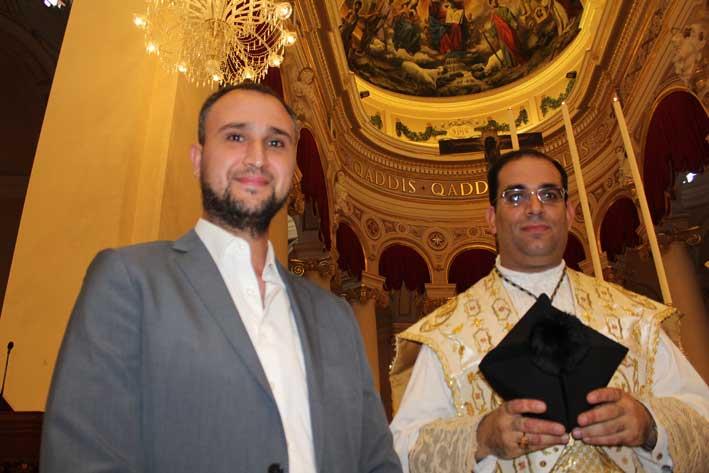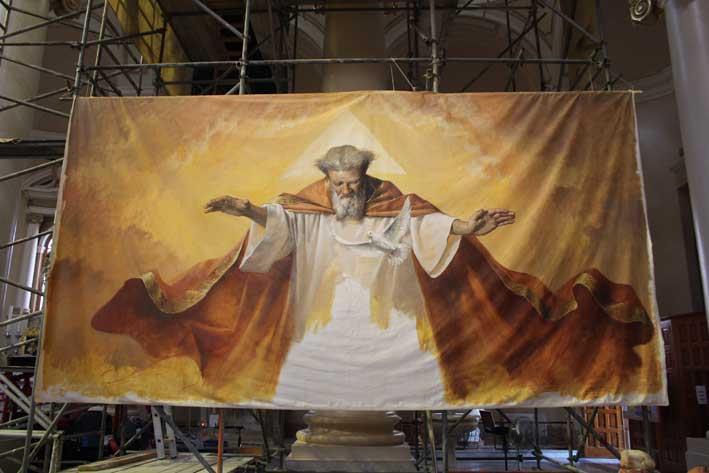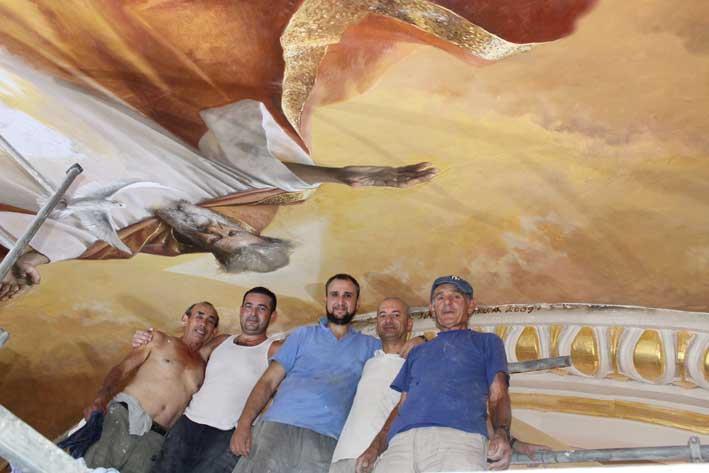Today, Paola parish is celebrating the feast of Christ the King. The parish is in fact dedicated to Christ the King; it was created by Archbishop of Malta, Mgr. Pietro Pace, in 1910. The first parish priest was Rev. Salv Chircop.
The church, which is considered as the largest on the island, was built in the shape of a Latin cross, on designs by Ġużè Damato, who was also one of its great benefactors. It started to be used as a parish in 1936. Archbishop Michael Gonzi consecrated it on 3 June 1967. It took over the title of parish church from the 17th century Baroque church dedicated to Santa Ubaldesca, built during the period when Malta was ruled by the Knights of St John; the papal bull, by Pope Urban VIII, granting the Order the permission to erect a church dedicated to St Ubaldesca, was issued on 31 July 1629.

All of Paola parish priests worked hard for the upkeep and embellishment of this large, monumental, magnificent temple; Il-Knisja ta' Kristu Re, at Raħal Ġdid. And today one can enjoy the interesting architecture, the interior décor, the crystal chandeliers and the various art treasures the church had been enriched with, with the generous contributions from the parishioners.

Canon Marc Andrè
The present parish priest is Canon Marc Andrè Camilleri. He came over from the parish of St Sebastian, in Ħal Qormi, where he served as vice-parish priest. He was officially entrusted with the spiritual care of the Pawlisti on 22 November 2014 and has Fr Herbert Friggieri S.J., Fr Keith Scicluna and Fr Gilbert Scicluna helping him.
Canon Camilleri - always clad in the traditional priest's black cassock - is a charismatic priest, always going round, meeting people, smiling, listening and giving encouraging advice. He is a very good singer who sings the song as the Almighty Lord asks of his disciples. Besides diligently taking care of the spiritual needs of the flock he has been entrusted with, he embarked on several envious projects for the church, some of which have already been completed with great satisfaction. Among these one finds the stucco bas-relief apostles by sculptor Lawrence Attard, four in the oval recesses high up above columns in the chancel, and eight in recesses above columns in the nave, near the freeze spanning around the church; the restored old mahogany pulpit (which used to lay abandoned in Santa Ubaldesca church) now installed on the first corner half column, on the left hand side of the nave; the paintings of saints on the sides of the altars, in the aisle on the right of the church, and those with episodes from the life of Christ on the four corners of the transepts - all by artist Manuel Farrugia; the two bronze statuettes of Saints Peter and Paul from Naples; the new, now titular statue representing Christ the King by renowned Alfred Camilleri Cauchi which is carried on shoulders in the annual procession being held today, the last Sunday of July; the four large precious crystal chandeliers hanging in the corners of the crossing; a new set of liturgical vestments and the decorated and gilded organ gallery, high up above the main door, in the interior of the church.

The artist
Manuel Farrugia, a young Gozitan artist still under 30, had been chosen to execute the paintings that have already been placed in situ in the church, on the merit that he had shown great talent in other works of his. He is promising and paints with a contemporary realistic and almost photographic style - an idiom which is immediately understood and touches the human soul.

A painting on the apse
His very recent large painting on canvas, approved by the Diocesan Commission for Sacred Art last May, was to be officially inaugurated for this year's festivity. It had been glued to the wall of the large apse during the first days of this month* and measures about 20 metres wide and 13 metres high.
In it, Farrugia depicts a glorious majestic, solemn Christ the King, sitting on a golden throne, with His right hand blessing the universe and mankind and His left hand holding an open book, with the letters 'A' on one page and 'Ω' on the other - the alpha and omega title of Christ and God in the Book of Revelations, beneath the outstretched arms of a radiant Eternal Father with cherubs on both of his sides and a white dove representing the Holy Spirit - the Holy Trinity - as the central attraction. On their right, they are flanked by an ecstatic seated Holy Virgin Mary and a humble St Joseph holding a white lilied staff, by her side. On the lower left hand corner of the painting, St John the Baptist preaches about the coming of the Messiah (Ecce Agnus Dei).
Meanwhile, in the opposite lower part dominates St Paul who brought Christianity to the Maltese in 60AD, beside a submissive young woman, representing Malta, dressed in normal female attire, holding a coat of arms with a Maltese Knights' eight-pointed cross (for the eight beatitudes). She is kneeling - as in an act of adoration (similar to that at the foot of Antonio Sciortino's Christ the King monument in Floriana) - beside an overlooking angel holding a silver censor; she reminds us of the XXIV International Eucharistic Congress, held in Malta in April 1913 - the dedication of the church to Christ the King was inspired by this Congress. Two of three white sheep, which symbolise the faithful, drink from the water flowing from seven branches of a stream (representing the seven Sacraments), among the greenery and rocks in the ground below.
All the figures, which had been rendered relatively young in age, are large and may be appreciated appropriately from deep down below, especially from the space in the crossing.
The drapery of the clothes which the figures wear is colourful and fills the artistic composition with movements that please the eyes and fill the minds with awe and hearts with spiritual gratification.
The painting was inaugurated and blessed, in the evening of last Saturday 21 July, after the celebration of a Solemn Mass.
The King of kings
The painting is sublime, it is an ensemble of colour, and beauty and grandeur! It provides a synopsis of theological and biblical teachings and includes an illustration of two historical landmarks of Catholic Malta. Moreover, it is recognition of, and credence in Christ the King - the King of kings - the one and only perfect, righteous and ever loving King, who is absolutely sovereign in His authority and eternal in His reign. It is a painting which symbolises the faithful's unquestionable belief in the 'Son of the Most High. And the Lord God ... [for whose] kingdom there will be no end.' (Luke 1: 32-33)
* The author was present, on the appropriate scaffolding, while the paintings of the Eternal Father and Christ the King were being glued to the wall of the apse, on Monday 2 July. He was again present, on the following Thursday, while the painting of St Paul was being glued.